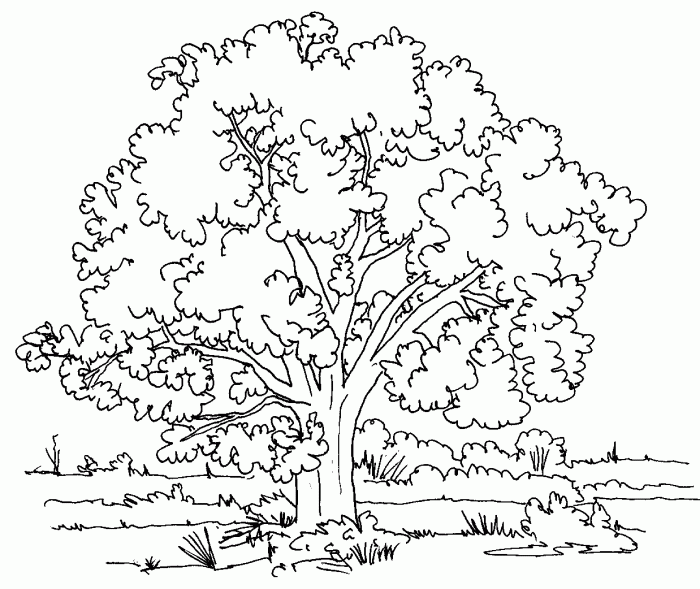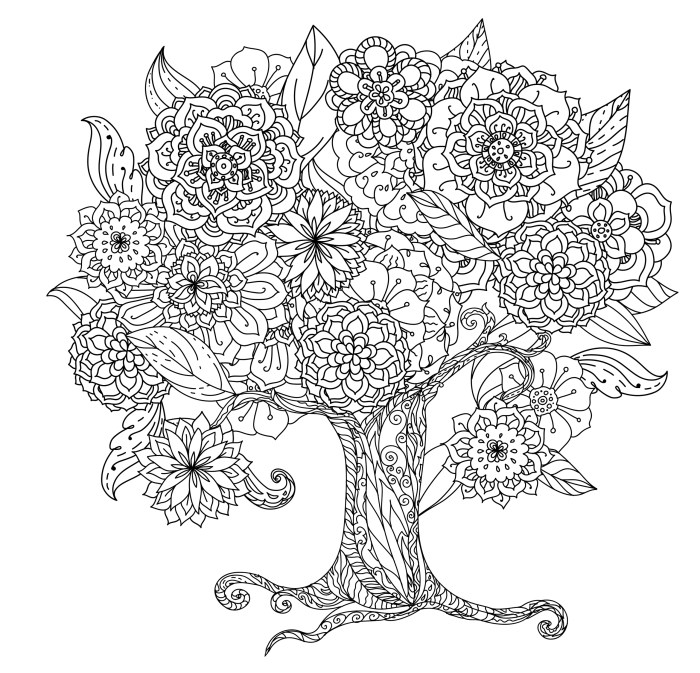Types of Trees for Coloring Pages: Coloring Book Pages Trees

Coloring book pages trees – Designing coloring pages featuring trees offers a wonderful opportunity to explore the diversity of the natural world and engage children (and adults!) in creative expression. The visual appeal of different tree species, with their unique leaf shapes, bark textures, and overall silhouettes, provides ample inspiration for a variety of artistic interpretations. This section will delve into several tree types suitable for coloring page designs, considering their visual characteristics and symbolic meanings.
Five Unique Tree Coloring Page Designs
The following descriptions Artikel five unique tree coloring page designs, emphasizing the distinctive features of each species:
1. Oak Tree: A majestic oak, its broad, lobed leaves reaching towards the sky, could be depicted with its thick, deeply furrowed bark. The coloring page could include acorns scattered at the base, adding detail and visual interest. The overall shape of the tree should be strong and sturdy, reflecting the oak’s reputation for strength and longevity.
2. Maple Tree: A maple tree’s design could focus on its iconic palmate leaves, with five distinct lobes. The coloring page could show a vibrant autumnal scene, with leaves in various shades of red, orange, and yellow. The branches could be depicted as slender and somewhat upward-reaching, creating a sense of delicate elegance.
3. Pine Tree: A pine tree’s design would showcase its needle-like leaves, clustered in bundles. The coloring page could feature a tall, slender pine, with its branches extending outward in a somewhat conical shape. The bark texture should be depicted as rough and scaly. Consider adding pine cones to further enhance the design.
4. Willow Tree: A weeping willow, with its long, slender, drooping branches, would lend itself well to a graceful, flowing design. The leaves could be shown as lanceolate and slightly serrated. The overall shape of the tree should be elegant and somewhat melancholy, reflecting the willow’s often-depicted association with sadness or reflection.
5. Birch Tree: A birch tree’s design could highlight its characteristic papery, peeling bark, often white or light-colored. The leaves are relatively small and ovate. The branches are often thin and delicate, creating a lighter, airier feel compared to the other trees. The overall impression should be one of delicate beauty and grace.
Visual Characteristics of Different Tree Species, Coloring book pages trees
The following table compares the visual characteristics of five different tree types, focusing on leaves, branches, and overall shape:
| Tree Type | Leaves | Branches | Overall Shape |
|---|---|---|---|
| Oak | Large, lobed | Thick, sturdy | Wide, spreading |
| Maple | Palmate, 5 lobes | Slender, upward-reaching | Rounded, symmetrical |
| Pine | Needle-like | Horizontal, layered | Conical, tall |
| Willow | Lanceolate, drooping | Long, slender, weeping | Weeping, arching |
| Birch | Small, ovate | Thin, delicate | Slender, upright |
Symbolic Meanings of Trees in Art and Literature
Trees frequently hold symbolic meaning in art and literature, often representing strength, wisdom, or growth. These symbolic meanings can be effectively integrated into coloring page designs.
Oak Tree Symbolism: The oak tree, often associated with strength, resilience, and longevity, could be depicted in a coloring page with strong, thick branches reaching towards the sky, emphasizing its powerful presence. The inclusion of acorns could further highlight the tree’s capacity for growth and renewal.
Willow Tree Symbolism: The willow tree, often associated with sadness, reflection, and grace, could be depicted with its long, drooping branches gently swaying in the wind. A muted color palette and a solitary setting could reinforce the willow’s contemplative symbolism.
Pine Tree Symbolism: The pine tree, often representing endurance, resilience, and hope, particularly in challenging conditions, could be depicted in a coloring page set against a snowy or rocky landscape, highlighting its ability to thrive in harsh environments. The evergreen nature of the pine could be emphasized visually through the use of deep, rich greens.
Coloring book pages featuring trees offer a calming and creative outlet, allowing for exploration of various shades of green and brown. For a different kind of artistic fun, you might also enjoy the charming characters found in strawberry shortcake coloring book pages , a delightful change of pace. Returning to the natural world, the intricate details of tree coloring pages provide another excellent opportunity for artistic expression and relaxation.
Illustrations and Descriptions

This section details three distinct tree illustrations suitable for coloring book pages, ranging from realistic depictions to stylized designs. Each description emphasizes key visual elements to guide the coloring process and inspire creativity.
Realistic Ancient Oak Tree Illustration
The illustration depicts a majestic ancient oak tree, its massive trunk easily ten feet in diameter at the base, tapering gradually upwards. The bark is deeply furrowed, a tapestry of browns and grays, with textures ranging from coarse, almost rope-like ridges to smoother, almost lichen-covered patches. Individual fissures are visible, some shallow, others deep enough to create shadowed crevices.
The branches, thick and gnarled, reach out in a wide, irregular canopy, their forms suggesting centuries of weathering and growth. The leaves are depicted realistically, clusters of deeply lobed, textured leaves in varying shades of green, some showing the lighter undersides. Light filters through the canopy, creating dappled shadows on the ground below, hinting at the tree’s immense age and the history it holds.
The overall impression is one of strength, resilience, and the enduring power of nature.
Whimsical Cartoon Tree Illustration
This illustration presents a playful, cartoon-style tree. The trunk is a vibrant, cheerful green, shaped like a slightly lopsided lollipop. Large, expressive eyes peer out from behind a smiling, slightly crooked grin carved into the trunk. The branches are thin, sprightly lines, ending in cheerful, oversized leaves shaped like hearts, stars, and other whimsical forms. Each leaf is a different bright color, ranging from sunshine yellow to fiery orange and deep violet.
A small birdhouse, shaped like a miniature mushroom, hangs from one branch, adding to the whimsical charm. The roots are exaggerated, playfully curling and twisting across the ground like playful snakes. The entire illustration is filled with a sense of lightheartedness and fun.
Stylized Geometric Tree Design
This stylized tree design utilizes geometric shapes and patterns for a sophisticated aesthetic. The trunk is a tall, slender rectangle, composed of repeating diamond shapes arranged vertically, creating a textured, almost woven appearance. The branches extend from the trunk at regular intervals, each a series of interconnected triangles, forming a visually appealing fractal pattern. The leaves are simplified into abstract shapes: circles, squares, and hexagons, each filled with intricate geometric patterns.
These patterns could include repeating lines, dots, or more complex designs, offering a wide range of coloring possibilities. The design process involves sketching the basic geometric shapes, then layering in the patterns, ensuring a balance between visual complexity and overall cohesiveness. The resulting design is visually striking, offering a modern and sophisticated alternative to more traditional tree illustrations.
Educational Aspects of Tree Coloring Pages
Coloring pages offer a fun and engaging way to teach children about trees and their importance in the environment. They provide a hands-on learning experience that can complement classroom lessons or simply spark curiosity about the natural world. The visual nature of coloring pages allows children to absorb information more readily, enhancing their understanding and retention.Coloring pages can be designed to effectively convey complex botanical concepts in a simple, accessible manner.
By incorporating labels and clear visuals, they can transform abstract ideas into concrete representations that children can easily grasp. This multi-sensory approach enhances learning and makes the educational process more enjoyable.
Parts of a Tree
A coloring page depicting a tree can effectively illustrate its key components. The page would show a tree with its roots firmly planted in the ground, a sturdy trunk rising upwards, branching out into smaller branches, and finally, a canopy of leaves. Each part should be clearly labeled: “Roots,” “Trunk,” “Branches,” and “Leaves.” The roots could be shown extending deep into the soil, the trunk depicted as thick and strong, the branches reaching towards the sky, and the leaves depicted in various shades of green.
This visual representation reinforces the understanding of a tree’s structure and function.
Tree Life Cycle
This coloring page would depict the stages of a tree’s life, starting from a tiny seed. The first image could be a simple seed, followed by a seedling sprouting from the ground. The next image would show a young sapling, gradually growing taller and developing more branches. The final image would showcase a mature tree with a full canopy of leaves, demonstrating the complete life cycle.
Each stage could be briefly labeled to enhance understanding, for example: “Seed,” “Seedling,” “Sapling,” and “Mature Tree.” This visual representation aids in comprehending the growth and development of a tree over time.
Types of Leaves
This coloring page could feature several leaves of different shapes and textures. The accompanying text would introduce the various types, emphasizing their distinctive characteristics.A brief introduction explaining the diversity of leaf shapes and textures would precede the illustrations. This helps to contextualize the various examples presented.
- Simple Leaves: These leaves have a single blade, such as those found on oak trees (lobed) or maple trees (palmate). The coloring page could include examples of both, highlighting their different shapes.
- Compound Leaves: These leaves are composed of multiple leaflets attached to a common stem, like those found on ash trees (pinnate) or horse chestnut trees (palmate). The coloring page could illustrate these distinct arrangements.
- Needle-like Leaves: These leaves are long, thin, and pointed, typical of pine and fir trees. The coloring page could contrast these with the broader leaves of deciduous trees.
- Scale-like Leaves: These small, overlapping leaves are characteristic of cedar and juniper trees. The coloring page could show their unique, tightly packed arrangement.
The visual representation of these different leaf types, coupled with their descriptions, allows children to develop a visual vocabulary for identifying various tree species.
